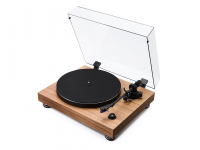
The Jitterbug is a fascinating new product from Audioquest, designed to improve audio through USB type-A connections. When Audioquest first announced the Jitterbug I was a little sceptical, but after reading initial previews and seeing the price I decided to take a punt on one…
 The Jitterbug is designed to improve, or possibly a better word is “restore”, the USB stream of data in the digital domain. It is firstly designed to remove unwanted noise currents and resonances which are generated by the switching power supplies that are present in PCs and many other digital sources. It is also designed to reduce digital jitter and information packet errors; the digital information reaches connected DACs with the correct timing signature and the DAC has to perform less error correction. What all this means is the DAC chip in your device can concentrate on converting the digital 1 and 0s into sweet, sweet music.
The Jitterbug is designed to improve, or possibly a better word is “restore”, the USB stream of data in the digital domain. It is firstly designed to remove unwanted noise currents and resonances which are generated by the switching power supplies that are present in PCs and many other digital sources. It is also designed to reduce digital jitter and information packet errors; the digital information reaches connected DACs with the correct timing signature and the DAC has to perform less error correction. What all this means is the DAC chip in your device can concentrate on converting the digital 1 and 0s into sweet, sweet music.

The Jitterbug can be used in any number of ways, not just with a PC and a DAC.

Audioquest suggest that running a second Jitterbug in an adjacent USB port will add further benefit.

They also suggest that you should plug one between your external hard drive and your PC to further reduce the extra noise.

You can also use one if you’re connecting your device and an external player.
So, was my scepticism justified? In a word, no. The first thing that I noticed was how dark the background became; my Arcam irDAC is a fine sounding piece of equipment, but suddenly with the Jitterbug plugged in there was a new sense of depth to the sound. The bass was much deeper and had greater detail, and this extra detail was present right across the frequency range. Music sounded much tighter, each note had a greater snap and gave each song a greater sense of timing.
Listening to a CD rip of Buddy Guy’s Bring ’Em In, the first note of Somebody’s Sleeping in My Bed sounds so crisp and beautifully layered you can hear all the instruments individually. The backing instruments become abundantly clear and yet the sound remains as cohesive. Changing to something a little less modern, Creedence Clearwater Revival’s 1968 cover of Suzie Q. The track sounds a little more live and natural in its sound – for instance with the drum intro at the beginning of the track, you can even hear the nature of the room the recording is made in. Moving on to Massive Attack’s Unfinished Sympathy, background samples and sounds just clear up and become a little more apparent, but do so without ruining the overall mix and becoming too in your face rather than a layer in the sound.
All these benefits apply right across the board as well; not just music, but also videos and games.
In terms of value for money, the Jitterbug is one the best purchases I have ever bought. The improvement in sound for such little outlay is remarkable and I can’t emphasise how much you should buy one if you use USB connections in your system. But don’t just take my word for it, give your local store a call to arrange an audition today.
Author: Jon, Cardiff store






For an amazing sounding portable system for the price I use the Jitterbug, a Behringer UCA202, and the Lepai LP-2020A with Monoprice speakers. This is great for outside use and easy to set up and take down.